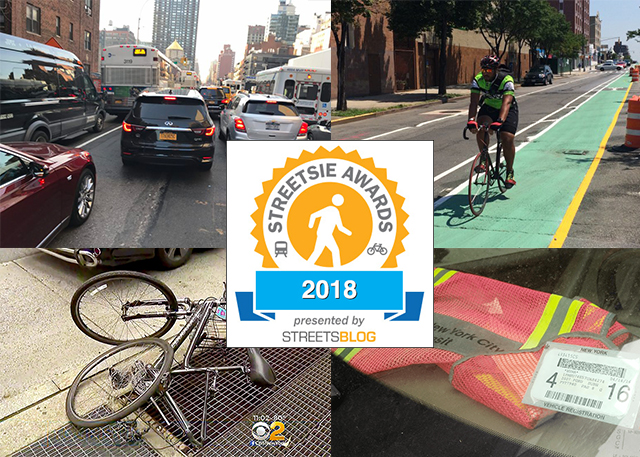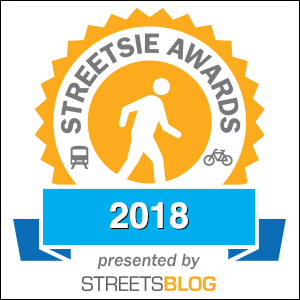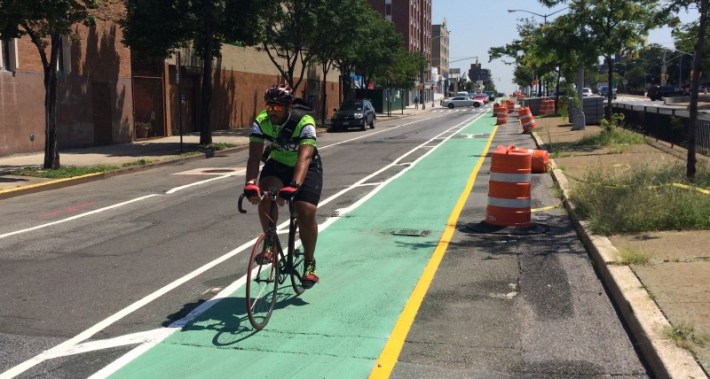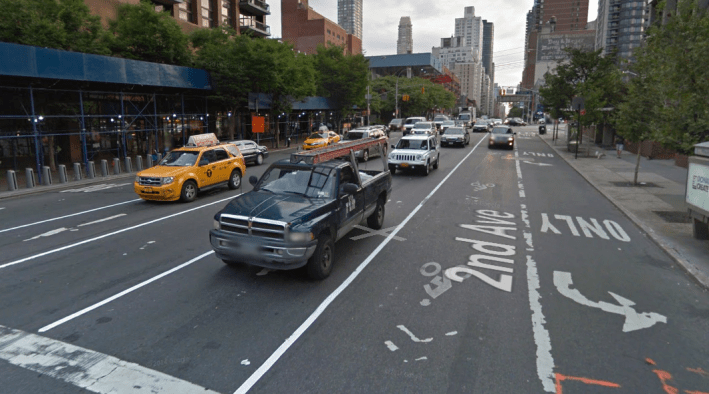The Department of Transportation, NYPD and other public agencies delivered several enormous successes this year — among them the fact that road fatalities appear on track to be less than 200 for the first time on record.
The city installed more than 16 miles of protected bike lanes for the third year in a row. The mayor's office defied Bronx NIMBYers and approved a life-saving street redesign along Morris Park Avenue. The NYPD wrote more bus lane violation tickets than the year before. The Business Integrity Commission is seriously cracking down on rogue carters and even devising a new system that will reduce deadly driving practices.
But there is still so much more work to be done. So we would be remiss if we did not present a Streetsie to this year's "Biggest Piece of Unfinished Business." The nominees are:
Queens Boulevard
In 2015, the city began its four-phase effort to transform the so-called "Boulevard of Death" into a safe roadway. Three phases have been completed. And in May, the city announced that the final portion, between Yellowstone Boulevard and Union Turnpike, would be completed in July.
We're still waiting.
Everyone knows that this particular project has been a huge success. Cycling is up, and fatalities are way down. In fact, no cyclists or pedestrians had been killed on any of the redesigned stretches until Dec. 17 of this year, when, police say, a pedestrian crossed against the light.
So what's the hold up? The mayor said he remains "committed" to finishing the job. But he said it oddly. "There are some real concerns and worries about how to implement it, but there’s no question we’re going to continue to do more to protect Queens Boulevard," he said.
Concerns? Streetsblog's David Meyer asked a follow-up question about whether Hizzoner's commitment meant extending protected bike lanes into Forest Hills, but the mayor didn't answer.
Council Member Karen Koslowitz opposes the final phase on a pro-parking/anti-safety platform — and de Blasio needs her support for his plan to close Rikers Island and open community jails.
Regardless, the work is not completed — and Streetsblog will be watching.
Second Avenue
It's not often that community boards beg the city to make their roadways safer for cyclists at the expense of car owners and their insatiable demand for free on-street car storage, but Community Board 8 in Manhattan did just that in September when it approved a city plan [PDF] to close a dangerous nine-block gap in the protected bike lane on Second Avenue near the 59th Street Bridge.
A month after the board's decision, the city announced a delay, without giving a reason.
We're still waiting. The city says it remains committed to the project — which is essential for the safety of cyclists — 40 of which have been injured in just those nine blocks since 2012. But let's also not forget the other nine-block gap in the protected lane between 43rd and 34th streets. Eighty cyclists have been injured along that horrible corridor near the Midtown Tunnel over the same period.
Taken together, that's one of the most dangerous commutes for cyclists in the city. Yet the work is not completed — and Streetsblog will be watching.
Central Park West
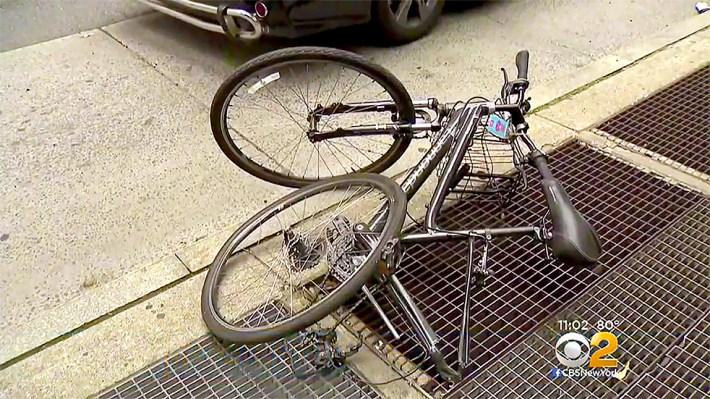
One of the surest ways for a road to get a quick redesign in this city is to be the site of a preventable death. Folks in Park Slope and Sunnyside are now enjoying protected bike lanes after the city moved boldly — and quickly — after people died in entirely preventable crashes.
Central Park West — where cyclist Madison Lyden was killed in August after she was forced into traffic because of a cab parked in the painted bike lane — has become an annoying exception. No street is more suitable for a protected bike lane: it is literally next to a park and car ownership in the area is among the lowest in the city. Plus, locals including Community Board 7 and Council Member Helen Rosenthal support the idea.
Regardless, the work is not completed — and Streetsblog will be watching.
Placard Crackdown

In May — 2017! — Mayor de Blasio launched a crackdown on placard abuse to rein in police officers and other city government workers who misuse their city-issued placard. There are more than 100,000 official parking placards in circulation and an untold number of fraudulent ones.
There is so much misuse of these placards that the Twitter account chronicling the daily abuse needs its own Twitter account.
The NYPD has resisted even modest efforts at reform, even as de Blasio still talks about launching a crackdown that he hasn't actually launched. “We really have to have some strong enforcement on this issue,” Council Member Margaret Chin said earlier this year. “We want to make sure that the trust between our government and citizens is there. Residents see this abuse every day. We’ve got to do something.”
Regardless, the crackdown has not happened — and Streetsblog will be watching.
More protected bike lanes (um, hello, Dyckman Street?)
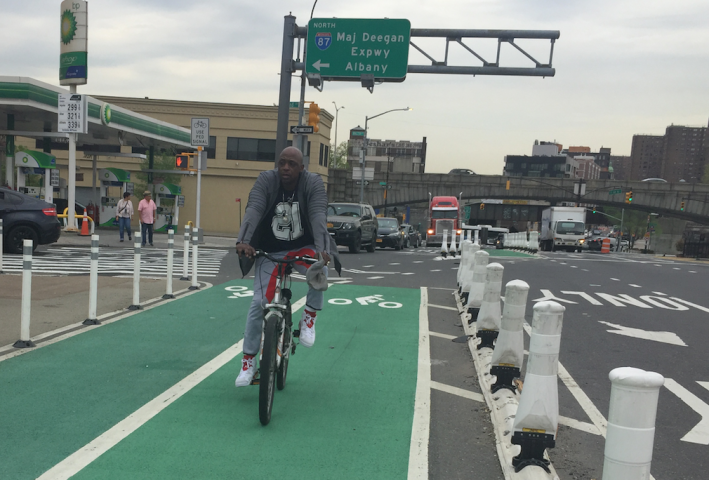
Mayor de Blasio failed to break his own record for building protected bike lanes, falling well short of last year's 24.9-mile mark. That shortfall is disappointing to advocates, including Council Member Ydanis Rodriguez, who has challenged the mayor to build 100 miles of protected bike lanes every year.
The mayor did add key links in the city's bike network, but missing his own projection of 29.4 miles of bike lane is a stinging failure in a city that should be building more and more bike lanes every year.
The work is not completed — and Streetsblog will be watching.
And one particular protected bike lane remains spectacularly unfinished: Back in August, the Department of Transportation announced it would remove protected bike lanes from both sides of Dyckman Street so that drivers could double park, as Manhattan Borough President (and Streetsie anti-award winner) Gale Brewer put it. But the mayor said he would review that decision. Four months later and the review goes on...
And the Streetsie goes to...
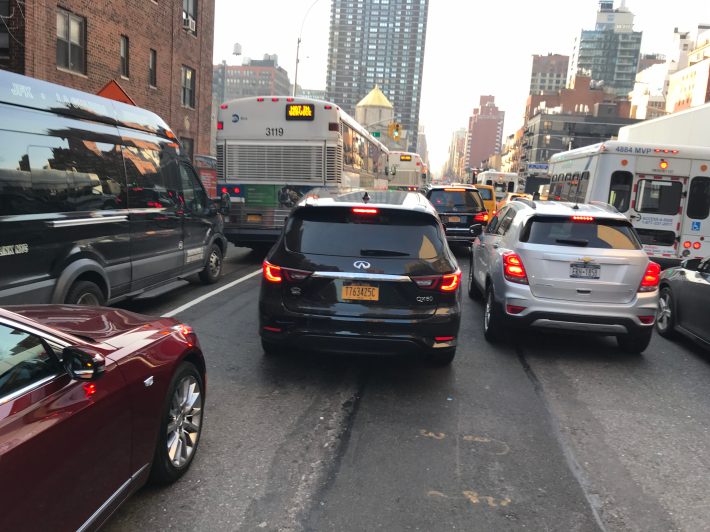
Second Avenue! We get no joy in saying this, but someone is going to be seriously injured in both gaps. The city must act immediately.

